Visualizations > Online Video
Fermilab | Chad Orzel | Sean Carroll | David Tong | Perimeter Institute
Fermilab – Don Lincoln
Fermilab’s YouTube channel has many online videos on topics in physics.
This Interesting Engineering article “Fermilab is Still Alive After CERN” (June 23, 2019) is a helpful overview of Fermilab.
Here’s a video on Quantum Field Theory with some interesting animation.
Published on Jan 14, 2016 – The subatomic world has long been known to be truly mind-bending, with particles that are waves and vice versa. Cats are alive and dead and everything is governed by probability. While this remains true, science has progressed since the invention of quantum mechanics and scientists currently use an extended form of quantum mechanics called quantum field theory or QFT. QFT teaches us that all particles are waves that interact with one another. If you thought the quantum world was weird before, modern ideas can give you a headache. In this video, Fermilab’s Dr. Don Lincoln tells us all about it.
In modern physics theory, one can picture all subatomic particles as beginning with a field. Then the particles we see are just localized vibrations in the field. So, according to quantum field theory, the right way to think of the subatomic world is that everywhere- and I mean everywhere- there are a myriad of fields. Up quark fields, down quark fields, electron fields, etc. And the particles are just localized vibrations of the fields that are moving around.
So those are the essential features of quantum field theory. Theoretical physics simply imagines that ordinary space is full of fields for all known subatomic particles and that localized vibrations can be found everywhere. These fields can interact with one another, like two adjacent tuning forks. These interactions explain how particles are created and destroyed – basically the energy of some vibrations move from one field and set up vibrations in another kind of field.
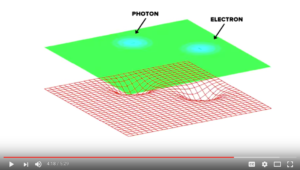
Fermilab’s “Higgs Boson 2016” video reflects on the 2012 discovery.
Published on Nov 16, 2016 – The Higgs boson burst into the public arena on July 4, 2012, when scientists working at the CERN laboratory announced the particle’s discovery. However the initial discovery was a bit tentative, with the need to verify that the discovered particle was, indeed, the Higgs boson. In this video, Fermilab’s Dr. Don Lincoln looks at the data from the perspective of 2016 and shows that more recent analyses further supports the idea that the Higgs boson is what was discovered.
You often hear people say that Higgs bosons interact more with heavy particles and that’s true. But there is a better way to say that. The correct way to say it is that particles that interact more with the Higgs field and boson get more mass. This is very subtle point, so I’ll say it again. It’s not that heavy particles interact more with the Higgs field. It’s that particles that interact more with the Higgs field become heavy. It’s the interaction with the field that comes first and the mass is the consequence. So how can we test this? Given this connection between the mass of particles and the degree to which the Higgs field interacts with them, we can predict into which particles the Higgs boson prefers to decay and which it doesn’t.
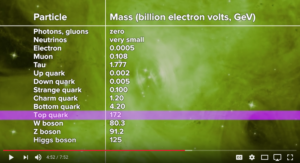
PIP-II: the new heart of Fermilab
Published on Mar 1, 2019:
The PIP-II project is an essential upgrade of Fermilab’s particle accelerator complex and includes the construction of a 215-meter-long linear particle accelerator. It is the first U.S. particle accelerator project with significant contributions from international partners. Research institutions in France, India, Italy and the UK will build major components of the new particle accelerator.
PIP-II will become the new heart of the Fermilab accelerator complex. Its high-intensity proton beams will provide a flexible platform for the long-term future of the Fermilab accelerator complex and the U.S. accelerator-based particle physics program. The upgrade will enable Fermilab’s accelerator complex to generate an unprecedented stream of neutrinos—subtle, subatomic particles that could hold the key to understanding the universe’s evolution—by creating the world’s most intense high-energy neutrino beams. This capability positions Fermilab to be the world leader in accelerator-based neutrino research. It enables the scientific program for the international, Fermilab-hosted Deep Underground Neutrino Experiment (DUNE) and Long-Baseline Neutrino Facility (LBNF).
Loop Quantum Gravity
Published on Aug 8, 2018:
The inability of scientists to create a theory of quantum gravity arises from long-standing tensions between general relativity and quantum mechanics. There have been few approaches with any success. In this video, Fermilab’s Dr. Don Lincoln explains one of the few promising ideas, called loop quantum gravity.
Sean Carroll’s July 10, 2018, podcast “Episode 2: Carlo Rovelli on Quantum Mechanics, Spacetime, and Reality” – an interview with Carlo Rovelli, provides some insights into the evolution of loop quantum gravity. Check out the audio recording and the transcript.
Carroll: … We’re both at a conference on the nature of time and the observer, so I’m taking the opportunity to sit down with one of the world’s experts in quantum gravity and have a chat.
Rovelli: ’76, ’78, something like that. And Chris Isham was a little bit of the guru of quantum gravity at the time and he had this fantastic review paper, which he was explaining the problem. And I read it, I didn’t understand much, of course, but it said space and time are not what you think they are, even after Einstein, even after quantum mechanics. And more than that, it said, space and time, we don’t yet know what they are, we’re not sure what they are. And here is a fantastic open problem, the core of modern physics, we don’t understand the basic grammar of the universe, and I said, “Wow, this is what I wanna do with the rest of my life.” And actually, I did.
In some sense, even though it’s a different notion of spacetime, general relativity is still within the classical Newtonian paradigm of physics. There’s something, spacetime, it has properties, it has curvature, and you can measure it as precisely as you want. And then we come to quantum mechanics, which is a wholly different thing.
And why points lose their meaning in quantum gravity is because the gravitational field is also space. The gravitational field doesn’t live in space, but is space itself. So in the moment in which you look at the quantum properties of the gravitational field, you’re also looking at the quantum property of spacetime, of space.
Rovelli: It’s loop quantum gravity, right. So loop quantum gravity has been born from the early attempt in the ’50s and the ’60s that you mentioned from the work of William DeWitt and many other people, but then has evolved into a more precise mathematical structure to describe the quanta of gravity, this granular structure of spacetime, … Since the gravitational field does not live in spacetime, it’s not a field in spacetime, but it’s spacetime itself, the quanta do not live in space or in spacetime, they are themselves spacetime, so they should be not confused with the gravitons, which are sort of a first approximation to quantum gravity, which are little particles like photons that move in space, they are very, very, very much brothers of photons. The quanta of gravity in loop quantum gravity are the grains out of which space or the gravitational field is built, and they are discrete, so that they cannot be further cut in smaller pieces.
Carroll: And is there a way to concisely explain the word “loop” in the phrase loop quantum gravity?
Rovelli: Yes, yes. First of all, it has remained a little bit historically. Now, it’s less loopy than in the beginning. But…
Carroll: In some sense, yes.
Rovelli: In some sense, right. Or it’s more loopy, I don’t know. The loop comes from this. The pixels themselves are, how would I say. They know who is next to who. They know who is next to who, so one can represent that with the links from loop to loop. So you have all these dots linked to one another, it forms a net. In fact, we call them network or more precisely, spin network, spin because there’s something of the mathematical spin in describing it. So imagine this network, and if you start from one of the pixel and go around link, link, link, link and loop back, you make a loop. So these are the loops on loop quantum gravity, and historically, the first mathematical description of these things that were found were only single sort of pixels along a loop, individual loops. This is when Ted Jacobson and Lee Smolin stumbled upon a solution of what was considered at the time the main equation of quantum gravity, which is called the Wheeler-DeWitt equation.
And these solutions depended on loops and so we started wondering, what are these loops? And slowly, we realized that these are the quanta. These can be thought as the individual quanta of space, and in fact, they don’t just loop or not so link, but they can cross, so it’s better to think as a network than a set of loops.
Carroll: And I know that at least at some point in the development of the theory, there was an image of almost like chain mail, in the sense that there were little loops that sort of tied around each other and that gave space its effective geometry and reality. Is that still how things are thought of now, or has that kind of evaporated?
Rovelli: Yes, yes, it’s a little less chain maily, chain mails as before, because at the beginning we were working really with still loops and we were thinking of loops, sort of linked to one another, so … I remember some point I was in Verona and I decided to buy a large number of key rings, and attached one to the other to make a sort of three-dimensional chain mail.
Carroll: This is what I’m remembering, good.
Rovelli: Yeah. And then I was going around… I gave a talk in Princeton, going with my chain mail, and John Wheeler, who was a big grandfather of thinking about, when he saw it he was very excited, because he said, “Yes, yes, that’s how I think about space, at the very, very small… ” And he ran away and came with a copy of his book, I didn’t know that, but in his book, there is a picture that he drew decades before, which is a sort of chain mail.
Chad Orzel
“Exotic Physics of an Ordinary Morning | Chad Orzel | TEDxAlbany” (~17′ Published on Dec 21, 2015): Starting with a toaster oven, Chad Orzel discusses everyday experiences related to topics in quantum physics.
“Schrödinger’s cat: A thought experiment in quantum mechanics – Chad Orzel“
Published on Oct 14, 2014 — Austrian physicist Erwin Schrödinger, one of the founders of quantum mechanics, posed this famous question: If you put a cat in a sealed box with a device that has a 50% chance of killing the cat in the next hour, what will be the state of the cat when that time is up? Chad Orzel investigates this thought experiment.
Lesson by Chad Orzel, animation by Agota Vegso.
“What is the Heisenberg Uncertainty Principle? – Chad Orzel“
Published on Sep 16, 2014 — The Heisenberg Uncertainty Principle states that you can never simultaneously know the exact position and the exact speed of an object. Why not? Because everything in the universe behaves like both a particle and a wave at the same time. Chad Orzel navigates this complex concept of quantum physics.
Lesson by Chad Orzel, animation by Henrik Malmgren.
Sean Carroll
Note: “Sean Carroll Versus the ‘Science Silo’” — Caltech Magazine, Summer 2019
While science is a powerful tool for understanding our universe, it is not the only one, insists Caltech theoretical physicist Sean Carroll. On Mindscape, his podcast, Carroll hosts conversations with interesting thinkers on topics across the academic spectrum: from superstring theory to the fall of Rome and everything in between.
[Carroll] I want science to be a part of the conversation when we talk about what it means to be an educated, curious human being. There’s an aspect of doing something like economics or law or philosophy that allows people to spread their thoughts a little bit more widely than someone who is a scientist and has a very narrow lane that they can go down. I want to establish that science should be part of this interconnected ecosystem rather than just a separate silo.
I have been really impressed by how important and real philosophy can be, and how things that might seem relatively narrow like, say, bioethics, end up reflecting more broadly on what a democracy is and how we reconcile different values. What happens when certain people feel strongly that something should be forbidden while other people think it is good? Whether that comes from biology or anywhere else, we have this problem in society of reconciling competing values. I actually do think all of the various conversations I have with guests build up to something and interact with each other.
“Cosmology and the arrow of time: Sean Carroll at TEDxCaltech” (~16′ Uploaded on Feb 25, 2011)
Keeping the Universe very, very smooth at early times is not easy. It’s a delicate arrangement. It’s a clue that the early Universe is not chosen randomly, there was something that made it that way, and we would like to know what. So part of our understanding of this was given to us by Ludwig Boltzmann, an Austrian physicist in the 19th century, and Boltzmann’s contribution was that he helped us understand entropy.
WIRED > YouTube > Physicist Explains One Concept in 5 Levels of Difficulty (published Oct 16, 2019)
Theoretical physicist Sean Carroll, PhD, is challenged to explain the concept of dimensions to 5 different people; a child, a teen, a college student, a grad student, and an expert.
David Tong
Quantum Fields: The Real Building Blocks of the Universe
The Royal Institution – Published on Feb 15, 2017According to our best theories of physics, the fundamental building blocks of matter are not particles, but continuous fluid-like substances known as ‘quantum fields’. David Tong explains what we know about these fields, and how they fit into our understanding of the Universe. Tong is a professor of theoretical physics at Cambridge University, specialising in quantum field theory.
Here’s the Q&A after the above lecture by David Tong.
What came first, quantum fields or the big bang? How can equation that we don’t fully understand be written at all? David Tong answers questions from the audience following his talk.
Q: … would you accept that despite the fact you’ve described that everything’s built up of fields and just interactions, ultimately there is there must always be some granularity and so the Greeks were essentially right?
A: No. [Laughter] Just no. There is a question … the question is at a fundamental level is nature discrete or continuous.
I see no evidence whatsoever for discreteness, or all the discreteness that we see in the world is something which emerges from an underlying continuum; so, that’s certainly a correct statement about the laws of physics as we currently understand it.
Now it may be that you go to a deeper level the discreteness takes over again. I don’t think so. Yeah you know … I wrote an article in Scientific American actually that elaborates on this in some detail. No, the quanta are emergent. So, for example, if you look at you know the Schrodinger equation is the equation of quantum mechanics and it’s what spits out the quanta of quantum mechanics — the fact that energy levels come in in discrete bits. There’s nothing discrete about the Schrodinger equation. The Schrodinger equation is something to do with a smooth field like like wave function. The discreteness is something which emerges when you solve the Schrodinger equation, so it’s not built into the heart of nature.
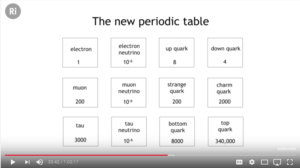
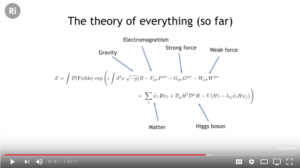
Perimeter Institute
1. Nobel laureate Art McDonald Public Lecture:
A Deeper Understanding of the Universe from 2 km Underground
Perimeter Institute for Theoretical Physics
Published on Apr 14, 2016
Dr. Art McDonald explains how researchers created an ultra-clean lab two kilometres underground in an active nickel mine to study fundamental physics, astrophysics, and cosmology, during his Perimeter Institute Public Lecture on April 13, 2016.
McDonald shared the 2015 Nobel prize in physics “for the discovery of neutrino oscillations, which shows that neutrinos have mass.” He presents an overview of his personal journey studying the “ghost particle” and establishig the underground research facility for that purpose.
2. Neil Turok Public Lecture:
The Astonishing Simplicity of Everything
Perimeter Institute for Theoretical Physics
Published on Oct 8, 2015
On Oct. 7, 2015, Perimeter Institute Director Neil Turok opened the 2015/16 season of the PI Public Lecture Series with a talk about the remarkably simplicity that underlies nature. Turok discussed how this simplicity at the largest and tiniest scales of the universe is pointing toward new avenues of physics research and could lead to revolutionary advances in technology.
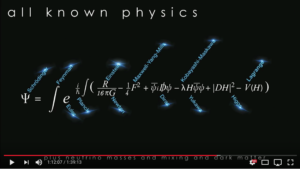
3. Lee Smolin Public Lecture:
Einstein’s Unfinished Revolution
Perimeter Institute for Theoretical Physics
Published on Apr 18, 2019
On April 17, in a special webcast talk based on his latest book, Einstein’s Unfinished Revolution, Perimeter’s Lee Smolin argued that the problems that have bedeviled quantum physics since its inception are unsolved and unsolvable for the simple reason that the theory is incomplete. There is more to quantum physics waiting to be discovered.
[1] Here’s an early review of Smolin’s latest book by astrophysics professor Adam Frank and posted on NPR: ” ‘Einstein’s Unfinished Revolution’ Looks At The Quantum-Physics-And-Reality Problem” (April 19, 2019) — which explores Quantum Foundations topics like:
- Interpretation of quantum mechanics
- EPR paradox
- Quantum nonlocality
- Bell inequalities
Does reality need realism? [“… a world out there, whose properties in no way depend on our knowledge or perception of it…”]
If that seems like a weird question to you, consider the fact that it’s the one most pressing for physicists and for their most successful theory about the physical world. That theory is called quantum mechanics …
Disagreement pretty much defines the debate about the meaning of quantum mechanics, and Smolin’s book is the latest addition to a stream of excellent works on the subject including Through Two Doors at Once: The Elegant Experiment That Captures the Enigma of Our Quantum Reality by Anil Ananthaswamy and What Is Real? The Unfinished Quest for the Meaning of Quantum Physics by Adam Becker. As you can tell from the titles, 100 years after its founding, quantum mechanics and reality remains a hot topic.
Einstein’s Unfinished Revolution is at its best when it’s laying out these foundations for the realist vs. anti-realist arguments.
4. Phiala Shanahan Public Lecture:
The Building Blocks of the Universe
Perimeter Institute for Theoretical Physics
Published on Nov 8, 2018
In her public lecture at Perimeter Institute on Wednesday Nov. 7, Phiala Shanahan provided a guided tour of the subatomic realm and described what supercomputer calculations of quarks and gluons can reveal about the origins of mass, the primordial nuclear reactions that power the Sun, and the nature of the elusive dark matter that permeates the universe.
Comments: “She is a superb presenter. … She is a really good communicator, going out of her way to be clear, not to mystify. … This was an exceptionally well-done lecture. … She is a skilled lecturer.”
